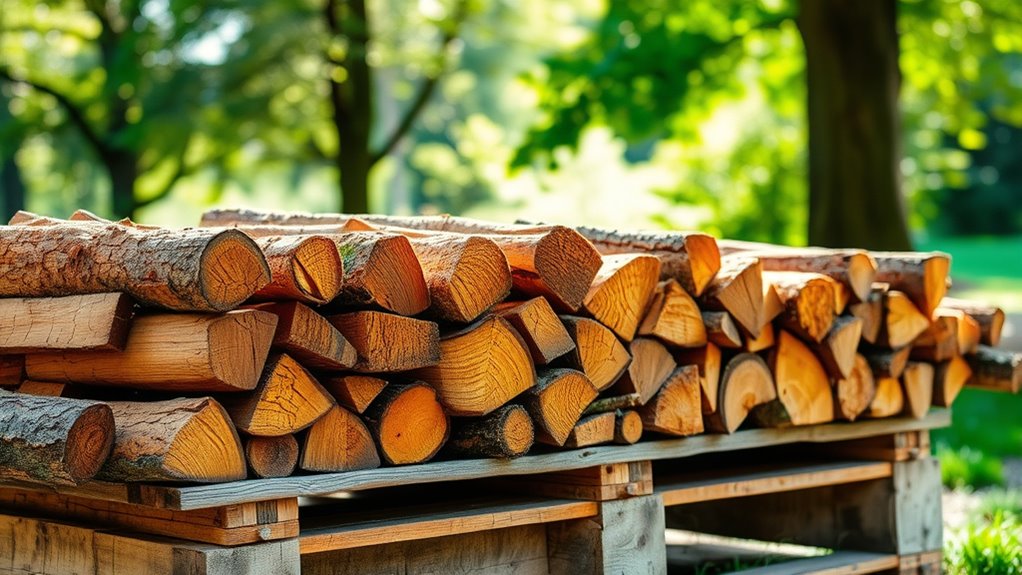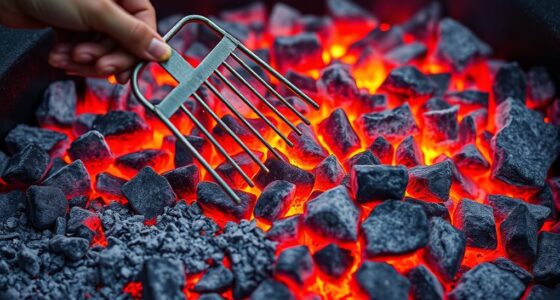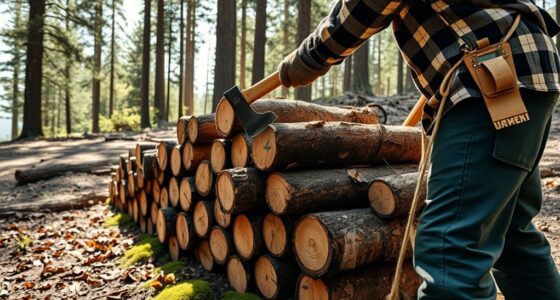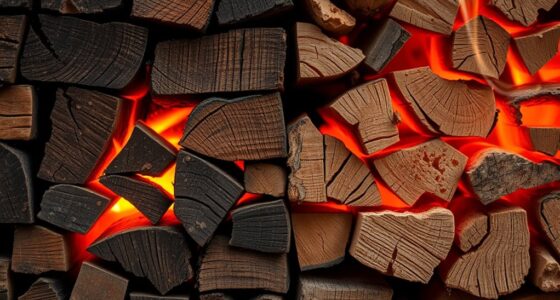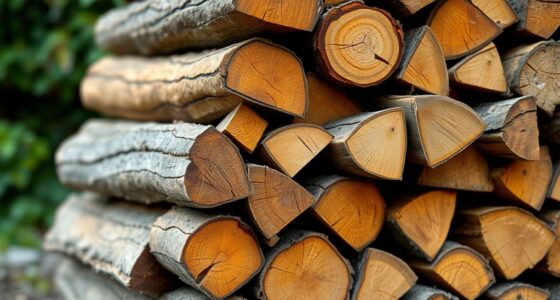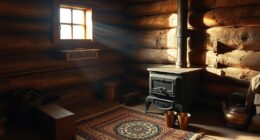To effectively stack and season firewood, choose a well-ventilated, protected location off the ground with pallets or cinder blocks. Arrange logs in a crisscross pattern to allow airflow, keeping them loose but stable. Cover only the top, leaving sides open for moisture to escape. Expect 6 to 12 months for proper seasoning; signs include cracks and a dull appearance. Continuing will reveal key tips to maximize burn quality and safety.
Key Takeaways
- Stack firewood in a crisscross or grid pattern with gaps to ensure proper airflow.
- Elevate logs off the ground using pallets or cinder blocks to prevent moisture absorption.
- Cover only the top of the stack with waterproof material, leaving sides open for ventilation.
- Allow 6 to 12 months for seasoning, checking moisture content with a meter or visual indicators.
- Proper stacking and seasoning improve fire efficiency, reduce creosote buildup, and extend stove lifespan.
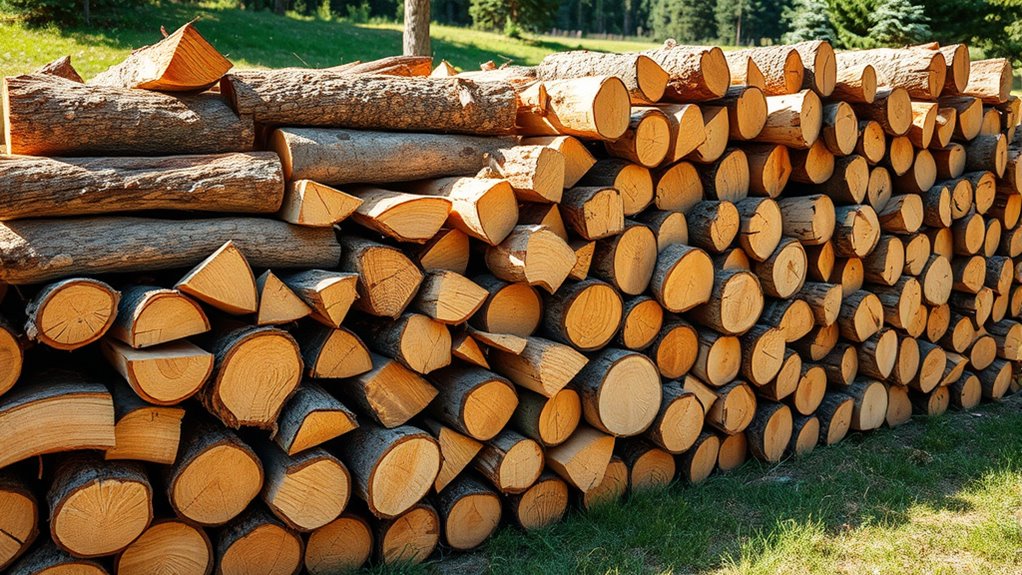
Properly stacking and seasoning firewood are essential steps to guarantee your wood burns efficiently and safely. When it comes to moisture control, how you store your wood makes all the difference. Effective wood storage techniques help reduce moisture content, ensuring your fire starts easily and produces maximum heat without excessive smoke or creosote buildup. The key is to keep your wood dry and well-ventilated, so it can season properly over time.
Proper wood storage keeps your fire dry, well-ventilated, and ready to burn efficiently and safely.
Start by choosing a good location for stacking your firewood. You want a place that’s protected from rain and snow but still allows air to circulate around the logs. Elevating the wood off the ground with pallets, cinder blocks, or a dedicated firewood rack prevents moisture absorption from the soil and encourages airflow underneath. This simple step is crucial for moisture control, as it prevents dampness from seeping into the logs and slowing down the seasoning process. Proper airflow around the woodpile is vital for effective seasoning. Additionally, selecting the right wood type can influence how quickly your wood dries and how well it burns.
When stacking, arrange the logs in a crisscross or grid pattern, with gaps between them. This maximizes airflow and facilitates even drying. Avoid stacking the wood too tightly—if air can’t circulate freely, the moisture becomes trapped, leading to mold or rot. Remember, the goal is to promote a steady flow of air through and around the woodpile. Cover the top of the stack with a waterproof tarp or roofing material, but leave the sides open. This setup protects the wood from rain and snow while still allowing moisture to escape and fresh air to enter. Proper ventilation is essential for preventing moisture buildup during the seasoning process.
Seasoning firewood properly takes time—generally, six to twelve months, depending on the wood type and climate. During this period, the wood’s moisture content should drop below 20%, which is ideal for burning. To check if your wood is ready, look for cracks in the ends, a dull appearance, and a lighter weight compared to freshly cut logs. Using a moisture meter can give you an exact reading, ensuring you’re not wasting time with green, unseasoned wood. Proper moisture control through good wood storage techniques not only makes your fire burn brighter and hotter but also extends the life of your stove or fireplace. Additionally, understanding the importance of moisture content helps you better judge when your wood is properly seasoned.
Consistently applying these wood storage techniques and paying attention to moisture control will make a noticeable difference in your firewood’s performance. Not only will your fires be cleaner and more efficient, but you’ll also reduce creosote buildup and prevent pest infestations. Investing time in stacking and seasoning correctly is a small effort for a big reward—warm, reliable fires that burn safely and efficiently every time.
Frequently Asked Questions
How Long Does It Typically Take to Season Firewood?
It typically takes about 6 to 12 months to season firewood properly. You’ll need to reduce the moisture content to below 20%, which depends on the wood density—denser woods like oak take longer to dry. To speed up the process, stack your wood in a well-ventilated, sunny area, and avoid stacking directly on the ground. Proper seasoning guarantees your fire burns hotter and cleaner.
What Is the Best Time of Year to Start Seasoning Firewood?
You should start seasoning firewood in late spring or early summer to maximize seasonal advantages. This timing considers ideal drying conditions, as warmer weather and longer days help wood dry faster. By beginning then, you give your firewood enough time to season properly before the colder months, ensuring it’s dry, easy to burn, and produces less smoke. Planning ahead lets you enjoy a reliable, efficient fire season.
How Can I Tell if Firewood Is Properly Seasoned?
You can tell if firewood is properly seasoned by checking its moisture content, which should be below 20%. Use a moisture meter for an accurate reading or look for visual cues like grayish color, cracks in the ends, and a dull surface. If the wood feels light, sounds hollow when tapped, and splits easily, it’s likely ready to burn. Properly seasoned wood burns hotter and cleaner.
Can I Stack Firewood Indoors Safely?
Think of stacking firewood indoors as like setting up a vintage radio—careful placement is key. You can do it safely if you choose an well-ventilated area away from direct heat sources. Use proper indoor storage to prevent mold and moisture buildup. Make sure the wood is adequately seasoned, and avoid stacking too tightly to promote airflow. This way, you reduce risks and keep your firewood dry and safe to burn.
What Are Common Mistakes to Avoid When Stacking Firewood?
You should avoid stacking firewood too high, which can block airflow and hinder proper drying. Don’t forget to check the moisture content; wood should be seasoned and below 20% moisture for efficient burning. Also, steer clear of stacking wood directly on the ground, as it traps moisture. Keep the stack stable and open for air circulation, ensuring your firewood dries evenly and burns safely.
Conclusion
Proper stacking and seasoning guarantee your firewood burns hotter and longer. Did you know seasoned firewood can be up to 50% more efficient than green wood? By following these simple methods, you’ll not only save money but also enjoy cleaner, safer fires. Just remember, patience is key—allow your wood to season properly, and you’ll experience maximum warmth and comfort all season long. Happy burning!

